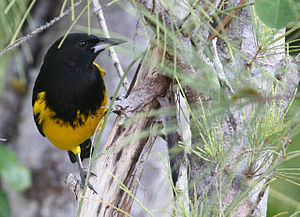Bahamatupial
| Bahamatupial | ||||||||||||
|---|---|---|---|---|---|---|---|---|---|---|---|---|

Bahamatrupial ( Icterus northropi ) |
||||||||||||
| Systematics | ||||||||||||
|
||||||||||||
| Scientific name | ||||||||||||
| Icterus northropi | ||||||||||||
| JA Allen , 1890 |
The Bahama Oriole ( icterus Northropi ) is a rare bird art the kind of New World oriole ( icterus ) from the family of Icterids (Icteridae). It used to be native to the Bahamas islands Abaco and Andros , today it only occurs with certainty on Andros. The species epithet honors the American naturalist John Isaiah Northrop (1861-1891), who discovered this species in 1890.
features
The Bahamatrupial reaches a size of 20 to 22 cm. In the male, the area from the head to the upper chest as well as the back, wings and tail are predominantly black. The rump , the small and medium-sized upper wing coverts (epaulettes), the underside below the upper breast and the lower wing coverts are yellow. The outer tail feathers are marked by small white tips. The iris is dark brown, the bill black, the basal half of the lower mandible and the legs are blue-gray. The female resembles the male, but the dorsal plumage is duller and lighter.
habitat
The Bahamatrupial is a resident bird and lives in open forests and fringing habitats. A strong bond with palm trees can often be observed; the spread to human settlements was apparently primarily possible through the widespread planting of coconut palms. The type also inhabited as coppice bewirtschafte deciduous forests, and mixed stands of pine and coppice.
Way of life
The food is largely unknown. Presumably it consists of nectar, fruits and arthropods . The breeding season is mainly between February and July. The hanging nest is made of plant fibers, mainly palm fibers. It is often attached to the underside of palm fronds or to the leaves of trees.
Danger
Once a common bird in the Bahamas, the Bahama Oriole in 2011 by BirdLife International "critically endangered" category ( critically endangered classified). It was last spotted on Abaco in the early 1990s, where it has now disappeared for unknown reasons. In 2009 Andros had a population of only 127 to 257 specimens, the reproduction rate of which is also extremely low.
A major problem is the "lethal yellowing" of a large number of palm species. This phytoplasmosis , which is presumably transmitted by the cicada species Haplaxius crudus , has already led to the death of the coconut palms on North Andros. In other parts of Andros the palm trees are healthy and the population density of the Bahamatrupial is higher. Another threat comes from the black cowbird ( Molothrus bonariensis ), which causes brood parasitism in Bahamatrupial .
Systematics
The Bahamatrupial was long considered a subspecies of the Hispaniolatrupials ( Icterus dominicensis ). However, studies of behavior, vocalizations, genetics and morphology have resulted in the Bahamatrupial having the status of an independent species since 2010. The Bahamatrupial is closely related to the Cubatrupial ( Icterus melanopsis ). The sequence deviation in the mitochondrial DNA (mtDNA) between the two species is small and amounts to only 0.7 percent, but there are deviations in the plumage coloration.
Individual evidence
- Jump up ↑ Price, MR and Hayes, W. K (2009): Conservation taxonomy of the Greater Antillean Oriole (Icterus dominicensis): diagnosable plumage variation among allopatric populations supports species status. J. Caribb. Ornithole. 22: pp 19-25.
- ↑ Sturge, RJ, Jacobsen, F., Rosensteel, BB, Neale, RJ and Omland, K. E (2009): Colonization of South America from Caribbean Islands confirmed by molecular phylogeny with increased taxon sampling. In: Condor 111: pp. 757-579.
literature
- RM Fraga: Family Icteridae (New World Blackbirds). In: Josep del Hoyo , Andrew Elliot & David Christie: Handbook of the Birds of the World. Volume 16 (HBW 16): Tanagers to New World Blackbirds. 2011, p. 771.
Web links
- BirdLife Species Factsheet
- Icterus northropi inthe IUCN 2013 Red List of Threatened Species . Listed by: BirdLife International, 2012. Retrieved October 16, 2013.